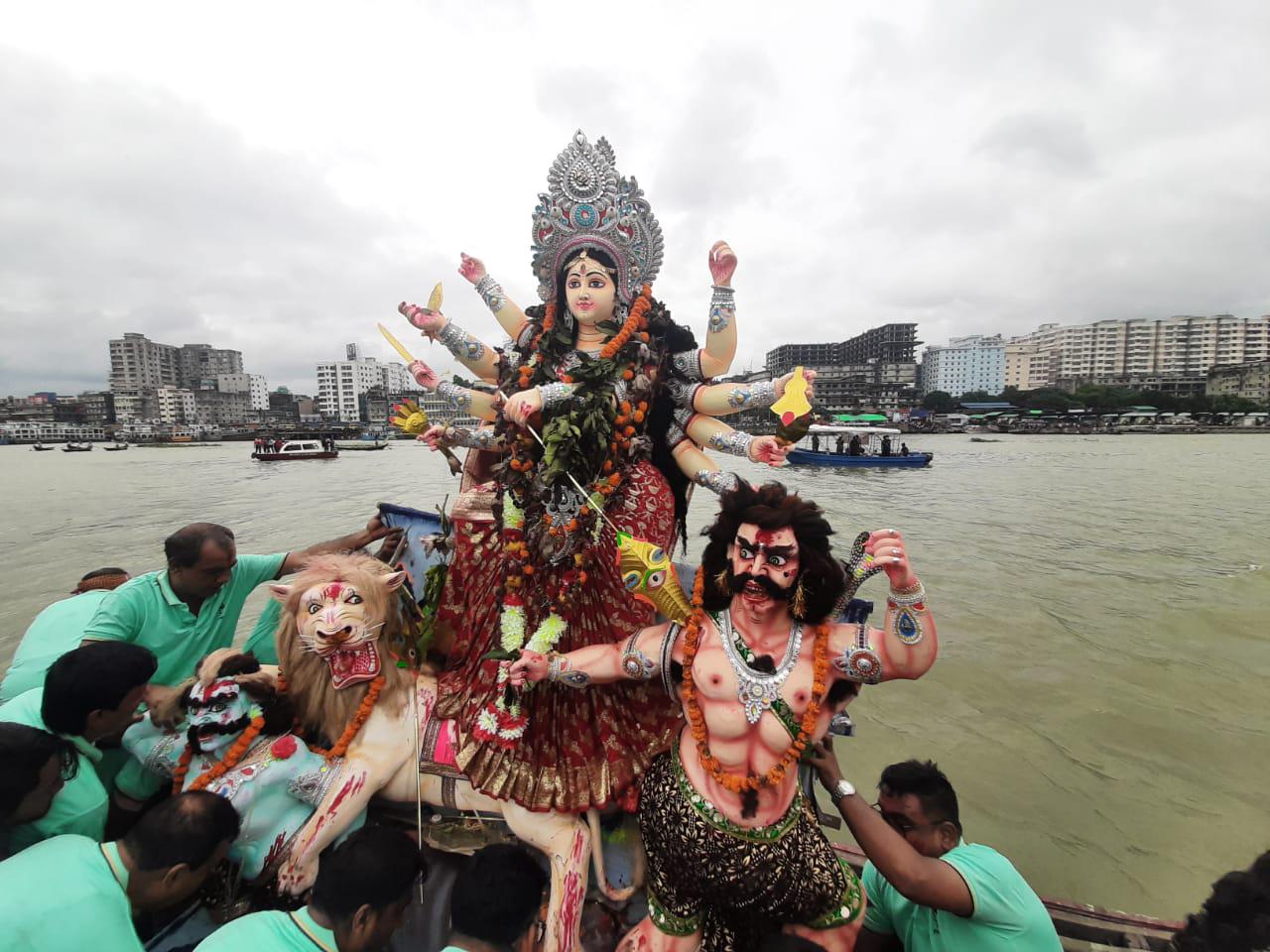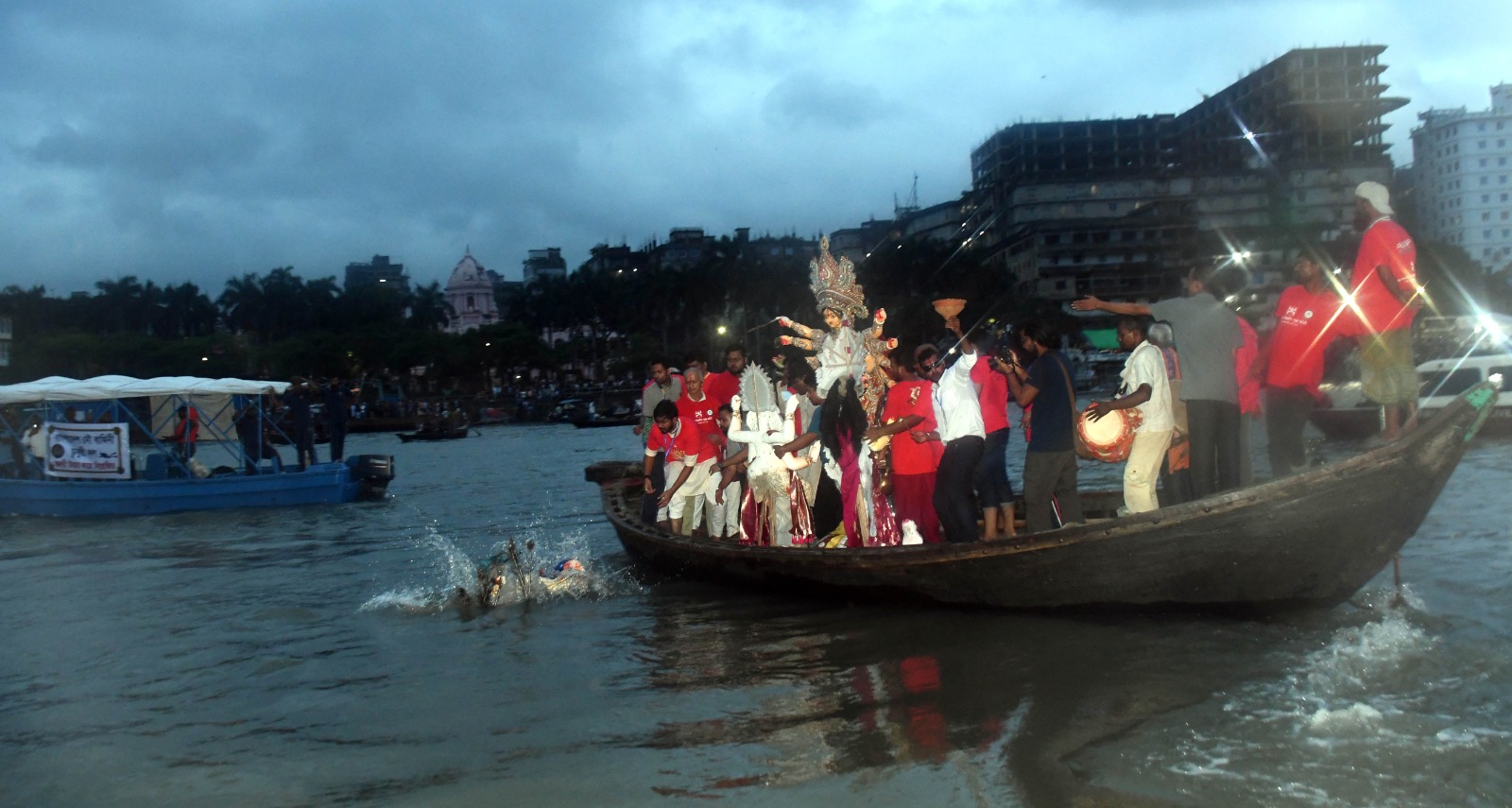News Flash

DHAKA, Oct 02, 2025 (BSS) - The five-day Sharadiya Durga Puja, the largest religious festival of the Hindu community, concluded today with the immersion of Goddess Durga's idols across the country, marked by deep devotion, vibrant rituals and solemn religious fervor.
On Bijoya Dashami, the final day of the festival, colorful processions carrying idols were brought out from temples and puja mandaps.
Devotees chanted mantras, beat traditional drums (dhak-dhol), blew conch shells and performed uludhoni (ceremonial ululation) before immersing the idols in nearby rivers, ponds or other water bodies.
Earlier in the day, married Hindu women, dressed in traditional white sarees with red borders, participated in Sindur Khela - a symbolic ritual where women offered vermillion and sweets to the goddess, then smeared each other's faces with sindur and exchanged greetings for marital bliss.
Temples and mandaps across the country, including Dhakeshwari National Temple, Ramna Kali Mandir, Ramakrishna Mission and Math, Siddheshwari Kali Mandir and others, witnessed huge gatherings of worshippers throughout the day.
The Dashami Puja was performed in the morning, followed by Darpan Bisarjan - a symbolic ritual offering the goddess's reflection to water before her formal departure.
Priest Sadhan Chakrabarty described it as the "real farewell," marking the end of the divine presence in the idol.
After the rituals, processions moved through city streets toward immersion points. Traditionally carried on bamboo frames, many idols were now transported on decorated trucks or boats for immersion, often taken mid-river for Bisarjan.
Devotees bid farewell to the goddess chanting "Aschhe Bochhor Abar Hobe" (Durga Puja will return next year), reflecting both joy and emotion.
In Dhaka, key mandaps at Dhakeshwari, Ramakrishna Mission, Kalabagan, Banani, Ramna, Shankhari Bazar and other areas drew thousands of devotees.
The capital's immersion ceremonies were held under tight security, with law enforcement ensuring smooth traffic and crowd management.

Similar scenes unfolded in divisional cities including Chattogram, Rajshahi, Khulna, Sylhet, Barishal, and district towns such as
Narayanganj, Faridpur, Dinajpur, Jashore, Kushtia, Tangail, Netrakona, and Satkhira.
Following the immersion, younger family members sought blessings from elders, while traditional sweets like chomchom, sandesh, kalojam and narkeler naru were shared among family, friends and neighbors.
This year's Durga Puja began on September 28 with Maha Shashthi, followed by Saptami, Ashtami and Navami on September 29, 30 and October 1.
The festivities formally commenced with Mahalaya on September 21, symbolizing the goddess's descent to earth from Mount Kailash, accompanied by her children - Lakshmi, Saraswati, Ganesh and Kartik.
As per traditional belief, Goddess Durga arrived this year on an elephant, a symbol of prosperity and good harvest.
Throughout the country, beautifully decorated mandaps showcased life-sized clay idols of the goddess slaying the demon Mahishasura, crafted by artisans over several weeks, reflecting exceptional religious artistry.
In the capital, major puja venues such as Dhakeshwari Temple, Ramakrishna Mission, Ramna Kali Mandir, Joykali Mandir, Jagannath Hall, and Siddheshwari Kali Mandir were adorned with elaborate decorations, lighting and thematic displays.
Shopping centers saw a festive rush in the lead-up to Puja, as people across communities prepared for the celebration.
According to Basudeb Dhar, President of Bangladesh Puja Udjapan Parishad, the number of mandaps increased this year to 33,355 nationwide, including 258 in Dhaka city.
The interim government allocated Tk 5 crore in support of this year's Durga Puja celebrations.
To ensure safety, extensive security measures were taken. Personnel from police, Ansar, RAB, BGB and other agencies were deployed at puja venues. Local volunteers supported law enforcement in managing crowds and maintaining order.
A central control room, coordinated by the Mohanagar Sarbajanin Puja Committee, was set up at Dhakeshwari Temple to monitor security and facilitate coordination across the capital.